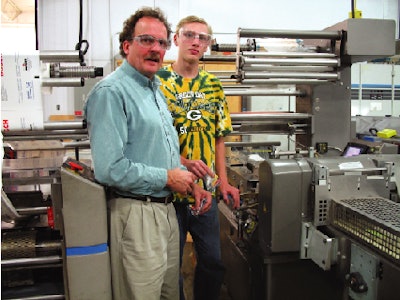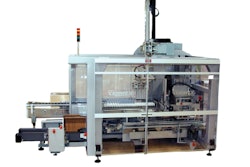
Reading, writing, and packaging machinery: There’s as much hitting the machines as hitting the books at Wisconsin Indianhead Technical College in New Richmond, WI. That’s apparent in a walk-through of an 8,000-sq-ft "lab" area adjacent to the classrooms. Packed with an amazingly diverse range of equipment, the lab is where students take their classroom learning along with their toolkits into the real world of packaging machinery.
It’s this hands-on emphasis that sets the school’s Automated Packaging Systems Technician program apart. Coursework for the two-year program includes Package Machine Rebuilding, Schematics, and Motion Controls.
"We have two lab areas full of about 35 packaging machines, from fill-and-seal cartoners to vertical and horizontal wrappers," says program head Kevin Lipsky, himself a 1979 graduate who joined the WITC faculty in 1986 (see www.packworld.com/view-24282). By 1989, he had helped develop the packaging curriculum into a two-year vocational program. "We use our variety of machines to develop the students’ confidence and provide experience with different products and materials."
Most of the equipment is donated by the industry, according to Lipsky, with the balance comprising equipment that WITC has invested in through procurement and refurbishment.
"Our program is unique to the degree that we have this amount of equipment, that we also focus on materials, students perform operations, and we offer installation classes," says second program instructor Joe Krear, who is also a WITC graduate, class of 1990. After graduation, Krear worked for Nordson where he was involved with installations of its hot-melt applicators. He joined the faculty in 1999.
One example of how students are trained took place in early 2008, when the program added an Amotek bagger donated by Optima Machinery. Students’ learning began on the back of the truck that delivered it. "We brought the machine in, installed it, powered it, and started the process of getting it operational," Krear explains.
WITC is located east of the Twin Cities of Minnesota in an area rich with automation and packaging vendors as well as packagers like General Mills. The school is part of a network of four technical colleges throughout NW Wisconsin. Other campuses are located in the cities of Superior, Rice Lake, and Ashland. Each has its own specialized courses, such as marine repair in Ashland. WITC New Richmond’s packaging program is supported by regional packaging vendors such as Bosch/Doboy, which is located a stone’s throw away, Tetra Pak, Krones, MGS, and also distant companies such as Econocorp.
Graduated ‘success’
Unlike traditional four-year university programs, the two-year program draws students of different backgrounds, ages, and experiences—a mix that Lipsky feels benefits all students.
It’s certainly a formula that has worked well, according to WITC’s annual graduate placement survey. "Our graduates find jobs and are paid well," asserts Lipsky.
For the 2006-2007 school year, WITC has had eight of nine graduates find program-related jobs, at an average starting salary of $49,000. That percentage is "down" from the previous year when it was eight of eight survey takers who found appropriate employment.
It’s an enviable record that Lipsky attributes to the program’s balanced, multiskilled approach: "One of the main reasons is the variety of skills the students possess," he says. "They understand materials and engineering documentation, and are able to work on a variety of machines—mechanical and electrical as well as hydraulic and pneumatic. Add to that diverse background computer and problem-solving skills, and you’ve got a good technician."
The coursework includes using engineering layout drawings to help students assemble, install, and troubleshoot machines. As crucial as the on-machine experience is, the learning doesn’t end there.
"The students gain a lot of confidence in tearing the machines apart and putting them back together, but they also learn human relations skills, including basic communications," says Lipksy. "We require written, oral, and technical reporting. When I was a student here, my instructor said, ‘Here’s the contact name, and there’s the phone. Get going.’ It’s also good for our students to interface with industry people at meetings and at trade shows."
Lipsky has seen a lot of changes in packaging over the years, reflecting trends he brings into the classroom.
"Most employers are really concerned about basic problem-solving and troubleshooting skills," says Lipsky. "That came out in your Packaging World 2007 Upskilling survey and report (see packworld.com/view-23436). That’s basically the same thing I taught 20 years ago, but it’s still true today.
"We also see the workforce retiring and taking away a strong mechanical skill set. Our students work on their mechanical skills with several courses in the program. Another trend is that most machinery now operates as part of a system. Our students are learning how to interface a machine with another machine.
"Motion control is another key aspect, the ability to apply robotics and smoother movements to machines. Simplifying machines makes them easier to change over."
Robotics vs motion control
One thing you won’t find, at least not yet, is much in the way of robotics. Lipsky feels that adding robots for their own sake to try and boost attendance is not as valuable for students as a multiskilled education that will better serve them after graduation. "What we’re interested in is kind of getting a feel for the types of robots as they integrate them on the equipment," he notes.
However, WITC looks at robotics within the broader context of motion control. "There’s a whole lot more to motion control than robotics," explains Krear. "There is the elimination of line shafts and gear drives. Motion control has added complexity to the electric aspect of machinery, but overall there’s machinery simplification."
WITC also offers an Associate Degree in Industrial Automation, Controls, and Networking for those seeking further advancement. IACN is a parallel certification program offered as an advanced controls option. Several students have completed this certificate and several are taking both programs, Lipsky says.
With the U.S. economy sputtering, Krear feels this is a great time for people to consider honing their skills. For those who want to add to their skills or for those undecided, Krear has advice: "Don’t sit there, do something. If you take courses, eventually something will come to mind that you want to do. There is plenty of variety in packaging."
For potential students in the area as well as for those further afield interested in the hands-on aspect of packaging machinery, WITC seems not just a handy choice, but a good one.
To listen to a Podcast with WITC instructor Joe Krear, see How WITC 'builds' packaging technicians.























